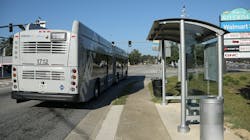The Federal Transit Administration (FTA) announced two projects advanced into the project development phase for FTA’s Capital Investment Grant (CIG) Program.
The Los Angeles County Metropolitan Transportation Authority’s (L.A. Metro) West Santa Ana Transit Corridor project was granted entry as a New Starts project, along with the Metropolitan Atlanta Rapid Transit Authority’s (MARTA) Clayton Southlake Bus Rapid Transit (BRT) project advancing as a Small Starts project.
MARTA notes the Clayton Southlake BRT is the first of several projects the authority hopes to advance as part of its MARTA 2040 program with requested CIG funding.
“This is an exciting milestone for both MARTA and Clayton County as we undertake the region’s first major transit expansion in decades,” said MARTA Interim General Manager and CEO Collie Greenwood.
The estimated $338 million BRT project will provide high-capacity transit service connecting the College Park MARTA Station to several key destinations in Clayton County including Airport Gateway, Riverdale Town Center, Southern Regional Medical Center campus, Mount Zion commercial corridor and Southlake Mall. Features of the BRT system include dedicated transit lanes, more frequent service, BRT-focused stations and transit-oriented development opportunities.
The project also includes adding 13 new BRT-branded stations with off-board fare collection, purchasing 10 BRT-branded electric buses and associated electric vehicle charging infrastructure and installing transit signal priority equipment at key intersections.
“Clayton County residents will benefit from the Southlake BRT because it will make a trip from College Park to Southlake Mall 19 minutes faster, making it easier to access jobs, healthcare and entertainment throughout the region,” said Clayton County Chairman Jeff Turner.
MARTA explains the recent federal Investment in Infrastructure and Jobs Act, which reauthorized surface transportation programs for five years, included a change to increase the eligibility for Small Starts to $400 million and increase the maximum amount of federal funding from $100 million to $150 million. These changes mean that the Southlake BRT project is eligible and can be awarded up to $150 million.
MARTA received support from the Clayton County Board of Commissioners last November to advance the project, and the MARTA Board of Directors followed, allowing staff to send a request for entry into the program in late December. Next steps include CIG budget request to Congress in August, completion of the National Environmental Policy Act (NEPA) in December and construction underway in summer 2024 with an operational date in 2026.
L.A. Metro project advances
L.A. Metro explains funding from FTA is a key step toward making the West Santa Ana Transit Corridor project potentially eligible for federal funding. The 14.8-mile Slauson/A Line to Pioneer route was also approved as the Locally Preferred Alternative (LPA) for the project’s initial segment between Artesia and Downtown Los Angeles.
"I am pleased and thankful to the Biden Administration for advancing L.A. Metro’s West Santa Ana Branch project in the Federal Transit Administration’s New Starts pipeline into the project development phase," said L.A. Metro Board Chair and L.A. County Supervisor Hilda L. Solis, representing the First District. "This is a critical step towards addressing disparities in communities across downtown and Southeast Los Angeles, whom I had the honor of representing on the Los Angeles County Board of Supervisors for seven years.
"Many of these communities suffer from severe pollution burden and lack sustainable mobility options. Once the West Santa Ana Branch comes to fruition, Southeast Los Angeles residents will finally have direct and quick access to Downtown Los Angeles and the rest of the county, opening up access to more jobs, schools and housing. As the chair of Metro’s Board of Directors, I remain committed to advancing this regionally significant project and all other projects like this that support the administration’s Justice40 initiative,” Solis concluded.
"This is a big moment for the West Santa Ana Branch project. I appreciate our federal partners for working quickly and acknowledging this project is a priority not just for L.A. County, but for the nation," added L.A. County Supervisor and L.A. Metro Board Member Janice Hahn. "Our Southeast L.A. communities deserve high quality transit, and this milestone gets us one step closer."
As the project enters the project development stage, L.A. Metro says it will retain eligibility as it completes the environmental review process, as well as engineering and design activities that the agency finds necessary. Once the environmental review process is complete, the FTA will extend the pre-award authority to project sponsors in project development to incur costs for engineering and design work necessary to develop a cost estimate, financial plan, utility relocation and property acquisition.
About the Author
Megan Perrero
Editor in Chief
Megan Perrero is a national award-winning B2B journalist and lover of all things transit. Currently, she is the Editor in Chief of Mass Transit magazine, where she develops and leads a multi-channel editorial strategy while reporting on the North American public transit industry.
Prior to her position with Mass Transit, Perrero was the senior communications and external relations specialist for the Shared-Use Mobility Center, where she was responsible for helping develop internal/external communications, plan the National Shared Mobility Summit and manage brand strategy and marketing campaigns.
Perrero serves as the board secretary for Latinos In Transit and is a member of the American Public Transportation Association Marketing and Communications Committee. She holds a bachelor’s degree in multimedia journalism with a concentration in magazine writing and a minor in public relations from Columbia College Chicago.

